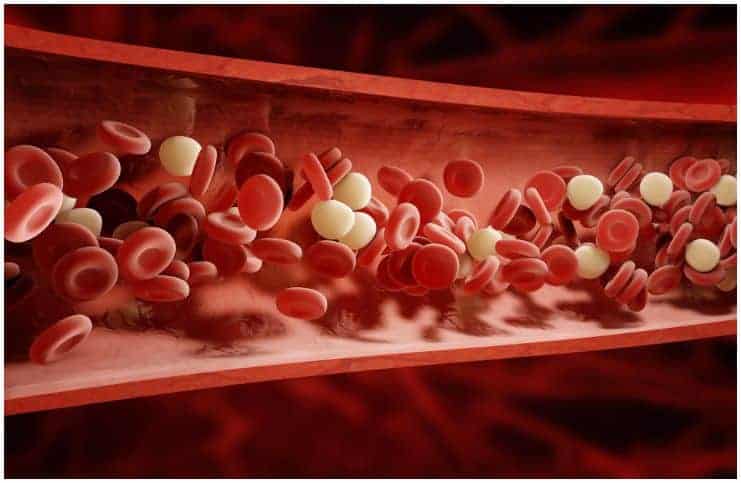Here are the top interesting facts about atherosclerosis (hardening of the arteries):
1 Atherosclerosis, also known as hardening of the arteries, is the build-up of a waxy plaque on the inside of blood vessels which transport the much-needed oxygen and nutrients from the heart to the rest of the body.
2 Plaque is made of fatty substances, cholesterol, cellular waste products, fibrin (a clotting material in the blood), and calcium.
Fatty and calcium-based deposits usually form in areas of the arteries which have been weakened by strain or hypertension.
3 As plaque builds up, it can cause life-threatening diseases, including – cerebrovascular disease (when hardening of the arteries occludes the arterial supply of blood to the brain) or coronary artery diseases (angina and heart attacks), which are the leading cause of death in the United States and worldwide.
4 Moreover, a plaque may rupture, spilling cholesterol, fat, and calcium into the bloodstream. This rupture may cause a clot, that can block the blood flow to a specific part of the body.
5 Hardening of the arteries is a slow, progressive disease that may start in childhood. It is mostly a disease of lifestyle and diet and contributes to most of the stroke and heart attack deaths.
6 It costs the US more than $200 billion every year. This total includes the cost of medicines, health care services, and lost productivity.
About 15,800,000 people in the United States have coronary artery disease, and approximately 630,000 die each year, which is 25 percent of all deaths.
7 In the European Union, about 1.9 million deaths result from diseases of the circulatory system, that is more than 37 percent of all deaths. This is also much higher than cancer, the 2nd most prevalent cause of death.
8 In the present day, in developed countries, death from infectious diseases has diminished considerably but death from heart disease has increased. Worldwide, it accounts for about 17.7 million deaths per year.
Symptoms
9 When hardening of the arteries is mild, and the arteries are not considerably narrowed, this condition causes no signs and symptoms. Hence, most adults are usually unaware that their arteries are slowly accumulating plaques. Eventually, this plaque accumulation causes serious problems, like – strokes and heart attacks.
10 Symptoms may include – kidney failure, hypertension, pain when walking, drooping facial muscles, difficulty speaking, sudden leg or arm weakness, and chest pain.
Causes
11 It begins with damage to the endothelium and is usually caused by:
- hypertension
- high LDL cholesterol – high cholesterol levels are the result of an unhealthy lifestyle, especially eating a diet that is low in fiber and high in saturated- and trans-fats;
- chronic inflammation due to injury but most likely due to smoking, consuming alcoholic beverages, and an unhealthy diet;
- smoking – it promotes plaque formation;
- elevated levels of triglycerides (store fat in the blood that the body can use for energy) increase the risk of this condition;
- type 2 diabetes mellitus.
The condition is more common for individuals with a family history of circulatory or heart disease or people over 65.
12 Over time, this condition can lead to:
Heart attacks
In this condition, the blood supply to the heart is blocked, leading to dizziness, shortness of breath, and chest pain which can radiate to nearby areas.
Carotid Artery Disease
This condition occurs when the arteries which supply blood to the brain are blocked. In its early stages, this condition doesn’t produce any symptoms, but over time, this may include – dizziness, confusion, severe headache, numbness in the face, breathing problems, and weakness.
Coronary Artery Disease
The coronary arteries are blood vessels that provide the heart’s muscle tissue with blood and oxygen. This severe condition happens when these arteries become hard with the plague. This prevents blood flow to the heart.
Angina
This happens when the heart muscle isn’t getting sufficient blood. Symptoms include – a pain in the chest, dizziness, sweating, shortness of breath, fatigue, nausea, or pain in the arms.
Abdominal Angina
When this condition narrows arteries that supply blood to the intestines, it leads to a form of abdominal pain called abdominal angina. Symptoms occur especially after having a meal.
Peripheral Arterial Disease
This condition occurs when enough blood can’t reach the leg muscles. Symptoms include – pain in the hips, calves, thighs, and buttocks – particularly when an individual is exercising.
Diagnosis
13 Angiography is a test that can directly show blocked arteries.
Treatment
14 The first step in fighting this condition is to keep it from getting worse.
This can be done through lifestyle changes which include – eating a heart-healthy diet, exercising every day, controlling high LDL cholesterol and hypertension, not smoking, and practicing stress-reducing techniques.
Prevention
15 To prevent hardening of the arteries, you need to improve your diet, stop smoking cigarettes, reduce your stress, regular moderate exercise (at least half an hour of walking per day), and maintain control of your LDL and total cholesterol level, blood pressure, and blood sugar.
Images credit – Shutterstock
READ THIS NEXT: Interesting Facts About Williams Syndrome
References https://academic.oup.com/aje/article/156/9/871/255904 https://bmcneurol.biomedcentral.com/articles/10.1186/1471-2377-11-22
